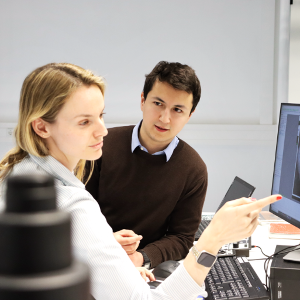Creating advanced catalysts with DNA origami
8 Apr 2025
Researchers from Munich developed a new way to design three-dimensional nanomaterials
8 Apr 2025
Researchers from Munich developed a new way to design three-dimensional nanomaterials

© Dominic Ziegler / LMU
Anyone aiming to develop efficient energy materials, such as those used for electrolytic hydrogen production, must think small and dive into the nanocosmos. LMU and TU Munich researchers have developed an innovative method to make porous, DNA-based nanostructures usable for a wide range of applications. This new technique bridges the gap between wet and dry chemistry, significantly expanding the application potential for three-dimensional nanomaterials. The teams, led by CeNS members Prof. Tim Liedl and Prof. Thomas Bein (both LMU), and Prof. Ian Sharp (TUM), report on how their method for 3D DNA origami works and the opportunities it opens up for sustainable energy technologies in a scientific publication.
Read full press release from e-conversion.
PUBLICATION:
Fabrication of Functional 3D Nanoarchitectures via Atomic Layer Deposition on DNA Origami Crystals; A. Ermatov, M. Kost, X. Yin, P. Butler, M. Dass, I. D. Sharp, T. Liedl, T. Bein, G. Posnjak
https://doi.org/10.1021/jacs.4c17232
CONTACT:
Prof. Tim Liedl
Research Group on Molecular Self-Assembly and Nanoengineering
Faculty of Physics and Center for NanoScience (CeNS)
Ludwig-Maximilians-University Munich
Email: tim.liedl@physik.lmu.de
Website: https://www.softmatter.physik.uni-muenchen.de/liedl_group/index.html